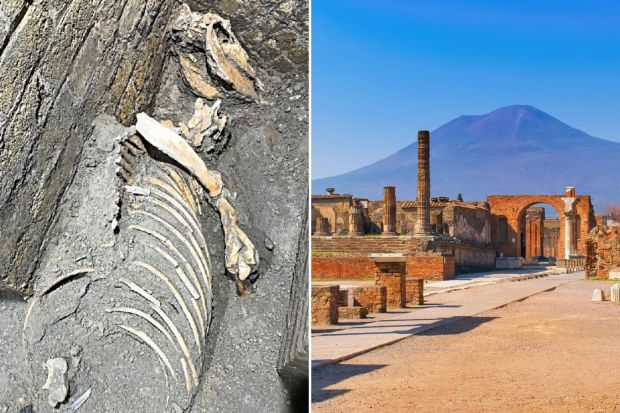Science
Archaeologists Uncover Evidence of Roman Life Resuming in Pompeii

Recent archaeological discoveries have revealed that Romans returned to the ruins of Pompeii after the catastrophic eruption of Mount Vesuvius in 79 AD. This eruption, which resulted in the deaths of thousands, had long led to the belief that survivors fled and never returned. However, new evidence indicates that some inhabitants did come back, albeit under vastly different circumstances.
Excavations at the site, located near modern Naples in the Campania region of Italy, have uncovered signs of life in the years following the eruption. Initially, it was thought that the destruction left the city permanently abandoned. Yet, experts now suggest that the poorest residents, unable to afford to relocate, returned to salvage what they could from the ruins.
In the wake of the disaster, the ground floors of many homes were repurposed as cellars equipped with ovens and mills, while some upper floors remained intact. According to Gabriel Zuchtriegel, the site director, “Thanks to the new excavations, the picture is now clearer: post-79 Pompeii reemerges, less as a city than as a precarious and grey agglomeration, a kind of camp, a favela among the still-recognisable ruins of the Pompeii that once was.”
New Insights into Pompeii’s Reoccupation
Prior findings hinted at the site being reoccupied, but these traces were often overlooked in the rush to explore more prominent features like colorful frescoes. Zuchtriegel noted that “the faint traces of the site’s reoccupation were literally removed and often swept away without any documentation.” This new perspective shifts the narrative of Pompeii from a solely tragic memory to one of resilience and adaptation.
The destruction caused by Vesuvius has dominated historical accounts, overshadowing the subsequent informal settlement that developed over the years. Archaeologists estimate that the death toll from the eruption represented between 15 and 20 percent of Pompeii’s population, primarily due to thermal shock from the volcanic gases. The aftermath saw survivors creating makeshift living conditions, lacking the infrastructure typical of a Roman city.
It is believed that this informal settlement persisted until at least the 5th century, illustrating a remarkable human response to catastrophe. Despite the challenges faced, people sought to reclaim their lives amidst the devastation.
The Eruption and Its Consequences
Pompeii was a bustling ancient Roman city before the eruption, which not only obliterated it but also buried it under layers of volcanic ash. The event, described as releasing thermal energy equivalent to a hundred thousand times that of the atomic bombs dropped on Hiroshima and Nagasaki, preserved the remains of the city for centuries. The site was lost to history for nearly 1,500 years until its rediscovery in 1599 and subsequent excavations that began in the 18th century.
The remains beneath the ash layers have provided invaluable insights into Roman life, as archaeologists have utilized plaster to recreate the poses of those who perished during the eruption. Mount Vesuvius, regarded as one of the most dangerous volcanoes in the world, remains an active threat, having erupted multiple times since the devastation of Pompeii, including its last significant eruption in 1944.
As ongoing excavations continue to uncover cultural and human remains, scientists remain vigilant. The recent findings not only enhance our understanding of Pompeii’s past but also highlight the enduring spirit of those who returned to the city in search of a new beginning amidst the ruins.
-

 Top Stories3 months ago
Top Stories3 months agoTributes Surge for 9-Year-Old Leon Briody After Cancer Battle
-

 Entertainment4 months ago
Entertainment4 months agoAimee Osbourne Joins Family for Emotional Tribute to Ozzy
-

 Politics4 months ago
Politics4 months agoDanny Healy-Rae Considers Complaint After Altercation with Garda
-

 Top Stories4 months ago
Top Stories4 months agoIreland Enjoys Summer Heat as Hurricane Erin Approaches Atlantic
-

 World5 months ago
World5 months agoHawaii Commemorates 80 Years Since Hiroshima Bombing with Ceremony
-

 Top Stories3 months ago
Top Stories3 months agoNewcastle West Woman Patricia Foley Found Safe After Urgent Search
-

 Top Stories5 months ago
Top Stories5 months agoFianna Fáil TDs Urgently Consider Maire Geoghegan-Quinn for Presidency
-

 World5 months ago
World5 months agoCouple Convicted of Murdering Two-Year-Old Grandson in Wales
-

 World5 months ago
World5 months agoGaza Aid Distribution Tragedy: 20 Killed Amid Ongoing Violence
-

 World5 months ago
World5 months agoAristocrat Constance Marten and Partner Convicted of Infant Murder
-

 Top Stories4 months ago
Top Stories4 months agoClimbing Errigal: A Must-Do Summer Adventure in Donegal
-

 Top Stories4 months ago
Top Stories4 months agoHike Donegal’s Errigal Mountain NOW for Unforgettable Summer Views









